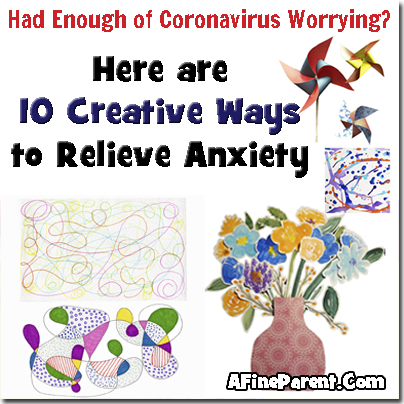 The world has changed in the space of a few weeks.
The world has changed in the space of a few weeks.
The outbreak of COVID-19 has caused drastic upheaval in our lives, and we are all searching for ways to relieve anxiety during this trying time.
Whether we are in quarantine, imposing self-isolation or practicing safe social distancing in an effort to flatten the curve, we are all struggling to make sense of the greater implications of the worldwide pandemic.
At the same time, we must deal with our day-to-day lives, which in many cases have been completely disrupted as our kids are required to stay home from school and we ourselves may be working from home.
Naturally, we are all stressed and anxious about the health and safety of our loved ones and the long-term social and economic fallout of the pandemic. As our own anxiety and worries clash with those of our children, the home front can quickly become a hotbed of uncertainty, worry, fear and stress.
How can we reduce our family’s stress levels? What can we do with a houseful of worried people and nowhere to go? What are some creative ways to relieve anxiety?
Doing creative activities together as a family is a great way to diffuse some of this anxiety. Art therapy has long been touted as a great stress reliever. Doodling, painting, cutting and pasting have all been shown to lower our cortisol levels, which are a marker of stress. Art can help put us in that meditative state known as the “flow” or “zone,” letting us escape, if only for an hour or so, the relentless anxiety-provoking news cycle.
Here at A Fine Parent, we have put together a list of art projects that you can do with the entire family to help get you through these trying times.
All of these activities are suitable for any age group. Think finger painting is only for toddlers? Try it! The soothing tactile feeling of squishing paint around on paper is incredibly therapeutic. You don’t even need to produce a finished, recognizable painting at the end of it. Simply the act of painting with your fingers will help calm you down.
(In a previous article we discussed How to Build a Creative Practice that will Ease Your Child’s Stress Levels. Please refer to that if you want to try finger painting or would like some additional art ideas.)
Since we are being encouraged to limit our movements outside the home, the following activities are designed to be done with the art supplies many of us likely have around the house already.
All you need are:
- Crayons
- Paints
- Markers
- Glue
- Paper
- Scissors
- Flour
- Water
- Salt
Scribble Art
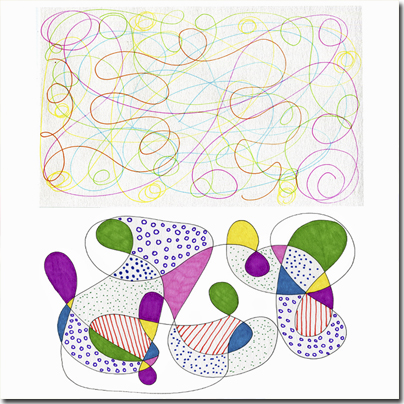 Let’s start with one of the easiest art activities. It’s good for any age and a guaranteed stress reliever: scribbling!
Let’s start with one of the easiest art activities. It’s good for any age and a guaranteed stress reliever: scribbling!
Scribbling reduces stress, whether it’s intense dark scribbles to get our frustrations out, or a more gentle, soothing flow of pen on paper.
While intense scribbling has its merits, in this activity, try to slow down your arm movement and swirl the pen or pencil around the page in a rhythmic pattern. There are two options to try here:
- Use different colors and continue to scribble over your first color, or
- Once you have filled the page with scribbles, use different colors to fill in the spaces and create a piece of abstract art.
Drip Paint Art
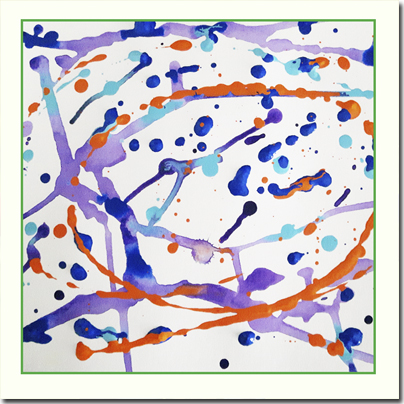 Another great abstract art technique is to go full-on Jackson Pollock and do drip paint art.
Another great abstract art technique is to go full-on Jackson Pollock and do drip paint art.
- Put down a plastic table cloth or cut a garbage bag open and tape it to the table to protect the surface.
- Put a few different colors of paint in small separate containers. You can use empty yogurt or applesauce containers, jam jars or cans.
- Add a bit of water to the paint containers. You can play around with consistency here – you just want it runny enough to pour easily, but still thick enough to control.
- Use a brush or pour from a cup or an empty squeeze bottle to drip the paint over the paper to create designs. The random act of dripping paint into swirly designs allows our minds to relax and concentrate on color, form and pattern, rather than what is happening in the world around us right this instant.
Make Your Own Scratch Art
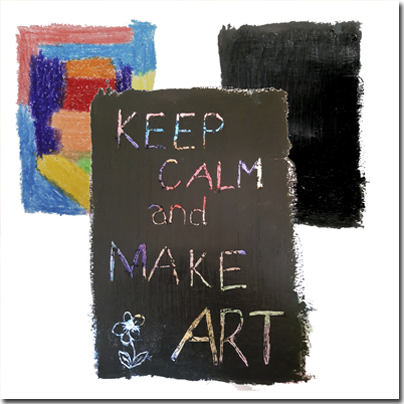 This activity involves some scribbling, a lot of coloring and a little bit of painting.
This activity involves some scribbling, a lot of coloring and a little bit of painting.
Grab a piece of paper and color the entire piece with crayons, making patches of different colors and pressing hard with the crayons to get a nice saturated hue.
After you finish the first layer, cover your work with a layer of black or dark blue tempera or acrylic paint.
Then, once the black paint dries, use a toothpick or the end of a paint brush to scratch away some of the darker color to reveal the colored paper underneath.
You can write a message for someone or etch a design!
Coloring Mandalas
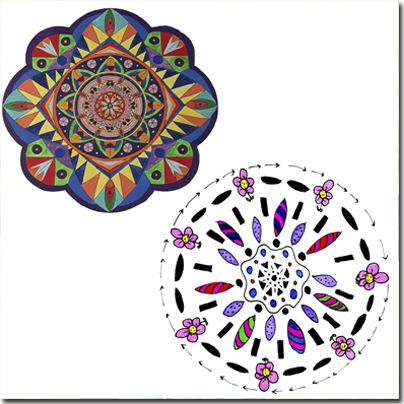 Simply coloring a picture is one of the best stress relievers around. For a fast and easy activity, dig out any coloring books you have around the house, and get coloring.
Simply coloring a picture is one of the best stress relievers around. For a fast and easy activity, dig out any coloring books you have around the house, and get coloring.
No coloring books? Filled them all in already? There are free coloring pages available to print off the internet.
But for maximum enjoyment and effect, create your own coloring page.
You’ve probably seen colorful mandalas; there are coloring books filled with them and you can also print them off the Internet. But you can easily make your own.
Here’s how:
Start in the middle of a piece of paper and draw a shape: a circle, a heart, a triangle, whatever. Then draw some more shapes around it. You can use images on Pinterest for inspiration, but really, all you need to do is keep drawing different shapes and lines, circles, ovals, tear drops, leaves, flowers, etc., radiating out from center design.
When you’ve finished, you can either color in your shapes, or trade your design with a family member so that everyone colors in someone else’s mandala.
Spring Bouquet Collage
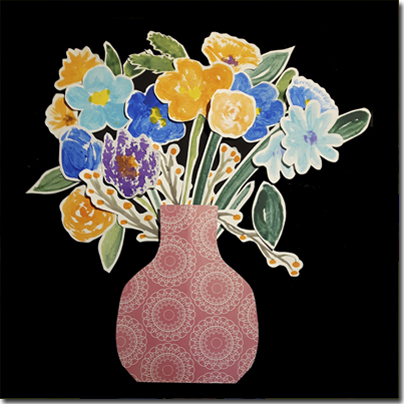 This activity involves all our favorite art techniques: painting and coloring, cutting and pasting!
This activity involves all our favorite art techniques: painting and coloring, cutting and pasting!
Draw or paint some flowers. Anyone can draw a flower: five petals and a stem…voila!
You can use markers, crayons or paints. Draw or paint several different flowers on a piece of paper. Make some leaves and stems to go with your flowers. Maybe some bugs or butterflies.
Next, make the vase: fold a sheet of paper in half, cutting out one half of a vase shape, and then unfold the paper to reveal the finished product. (Vases can be any shape! A square works as well as anything, so no need to get too fancy.)
Now, cut out your flowers, leaves, stems and bugs.
Finally, compile your artwork into a colorful floral collage bouquet: on a separate piece of paper, glue your vase and then glue your assortment of flowers coming out of it. Now you have a fun piece of art to hang on the wall or send to a friend or grandparent.
Doodle City
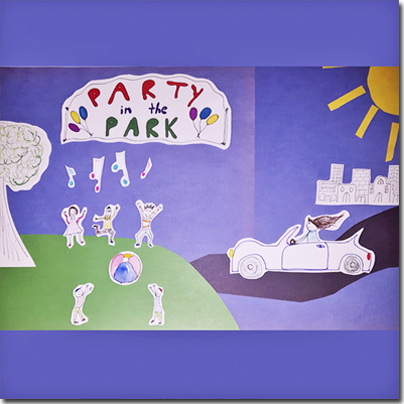 Making a doodle city is similar to the bouquet activity and ideal for kids and adults who prefer to doodle buildings, cars and people instead of flowers.
Making a doodle city is similar to the bouquet activity and ideal for kids and adults who prefer to doodle buildings, cars and people instead of flowers.
Draw all the things that make up a city: the taxis and the bakeries, the people and the playgrounds. You can use any art medium you want, but markers or colored pencils are always a good bet.
Can’t draw people? Stick figures work just fine! There’s no judging here. (And a doodle farm is fun too: draw a barn and all the animals who live there.)
Once you’ve got a sheet of doodles, cut them out and create your city (or farm, or alien planet civilization). On a separate piece of paper you can draw a map of your city and place your buildings along the streets and your cars along the road.
[Note from editor: This is a great way to give in fantasy what your littles can’t have in real life at this time. Granting wishes in fantasy has been shared by several of our expert guides as a great way to diffuse upsets in many of our Positive Parenting Conference masterclasses.]
Diorama of Us
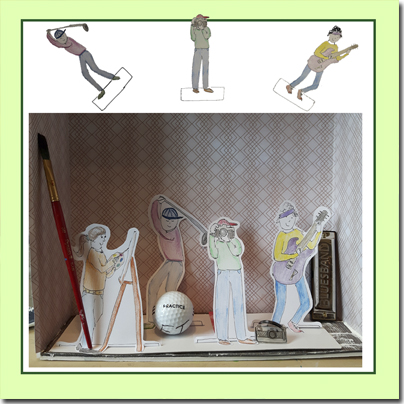 I love a mixed-media diorama. There is something about combining found objects and making 3D creations that can occupy me for hours.
I love a mixed-media diorama. There is something about combining found objects and making 3D creations that can occupy me for hours.
This activity involves art, collage and objects found around the house. It’s part art, part scavenger hunt, and the entire family can be involved.
You can make this a group activity and have each family member contribute something that represents your family and the people in it, or each family member can make their own personalized diorama.
- Paint a shoe box, box top or even a cereal box with the front cut out. This will be the base of your diorama. If you prefer, cover the box in colorful paper or collage it with pictures that represent you: pictures of dessert, sports equipment, whatever you find meaningful.
- Next, on separate pieces of paper, draw pictures of things you like: books, soccer balls, trees for climbing, super heroes. Cut out the pictures, making sure to leave a tab of paper at the bottom so you can fold the tab and use it to glue your pictures into your diorama frame. (Refer to the attached picture as a guide.)
- Now, complete your diorama by adding small objects that represent you or that give you good memories of things you’ve done: a favorite Lego minifig, a rock or piece of beach glass from a family vacation, a ribbon you won in a cross country race.
Whether you make one big family diorama or each person works on his or her own, this activity can serve to remind us of all the good things we like or have done, things to be grateful for and happy memories we’ve shared.
Paper Pinwheel
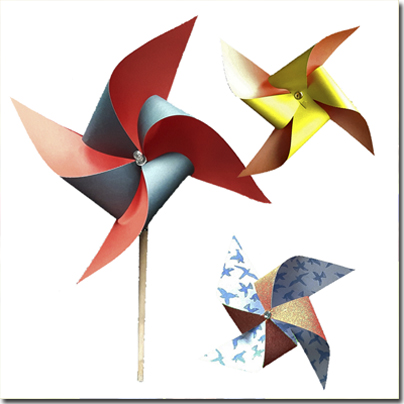 There’s something soothing about cutting and folding paper. Making a paper pinwheel combines a focus of attention, the relaxation of a simple craft and the end-result satisfaction of a completed craft. All serve to get your mind off any immediate worries.
There’s something soothing about cutting and folding paper. Making a paper pinwheel combines a focus of attention, the relaxation of a simple craft and the end-result satisfaction of a completed craft. All serve to get your mind off any immediate worries.
To make a paper pinwheel, cut a square out of a colorful piece of paper. Then cut in from the corners toward the center, and fold four of the corners in. You can use this printable template for guidance.
When you have a finished pinwheel, embellish it however you like. You can glue the edges in place and affix faux gems in the center for decoration, you can poke holes in the center and corner dots and use a brad to attach everything or you can use a push pin to attach the edges and then push the pin into wooden dowel for a pinwheel that spins.
Home-made Playdough
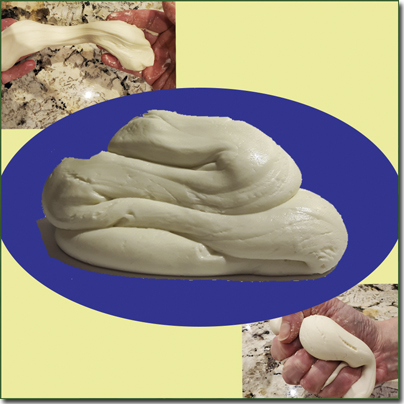 The squishy, tactile feel of playdough between your fingers is guaranteed to lower your heartbeat and sooth your stress for a little while. It’s a home-made stress ball.
The squishy, tactile feel of playdough between your fingers is guaranteed to lower your heartbeat and sooth your stress for a little while. It’s a home-made stress ball.
You can also get out your cookie cutters and make shapes, make pinch pots or make a family of worms by rolling your dough into cylinders.
There are lots of recipes on the internet for making homemade playdough. You can check out any of these on Pinterest, but I like this one, because it doesn’t require Cream of Tartar. (Not that I’m against it, I just don’t happen to have it in my cupboard, and I’m not making a trek to the grocery store just for that).
I also like this recipe for stress relief dough made with cornstarch.
Once you’ve made your dough, you can squish it, roll it or cut it with cookie cutters.
Or you can turn this into a sneaky teachable moment by making a Playdough pulse meter and measuring your heart rate. Have the kids do a few jumping jacks and then use the pulse meter to measure their heart rate. Next, have them take some deep breaths and lower their pulse. (Fun and learning together – every parent’s dream activity 😉).
Sensory Bag
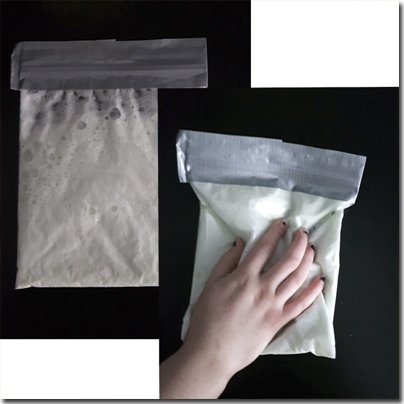 Finally, here is one last craft that isn’t so much an art activity, but it’s a great way to end your day or to grab when things seem overwhelming. Make a sensory bag!
Finally, here is one last craft that isn’t so much an art activity, but it’s a great way to end your day or to grab when things seem overwhelming. Make a sensory bag!
Similar to a stress ball or playdough, a sensory bag provides that soothing tactile sensation that encourages a calming, meditative state.
You will need a zip-close bag and some duct tape to ensure your bag is securely sealed. Then find some squishy things to put inside. One option is to use hair gel, or you can mix together some cooking oil, water and food coloring. A third option is to use finger paints.
Pour your ingredients into the bag, seal the bag and squish. Take some deep breaths as you do: breathe in for a count of four, and out for a count of four. Do this four times.
Keep calm and create.
The 2-Minute Action Plan for Fine Parents
When you’re looking for a way to relieve some anxiety, choose one of the above activities. Gather your supplies and prepare your work surface if needed. Turn off all devices, call the family together and settle down for a relaxing hour of creating.
Make a conscious decision not to talk about the current crisis for the time being, but rather focus on what you are doing, the colors you are using, the squishy feel of the dough or the ideas you have for the doodle city.
After trying some of the activities, reflect on how you feel. Is your heart rate a little lower? Are your shoulders a bit more relaxed? Have you just spent half an hour thinking about something other than the current crisis?
Ask yourself where and how you can incorporate art into your everyday life.
The Ongoing Action Plan for Fine Parents
If you are facing a couple of weeks or more of isolation, make time each day for an art activity.
Try the ones listed above, but also get the whole family involved in coming up with other creative crafts to make.
Assign each family member a day where they get to choose the activity.
When you’re finished with your art activity, encourage members of the family to talk about what their creations mean to them and what they are feeling.
You could also use this as an opportunity to connect with friends and family you aren’t able to see in person by mailing your artwork to them, or simply emailing or texting them pictures of it.
And if you are part of our Positive Parenting Village Facebook Group, come show off what you made! Ooh-ing and aah-ing over member-submitted masterpieces is our kind of stress relief. 😉
It seems to me that always and in everything you need to be guided by desire. When a child is interested in exclusively academic drawing and painting, I sincerely admire both him and his teacher. If these genres are difficult and reluctant, I think you need to try to abandon the strict rules. For me, you need to create solely of your own free will – there is no other way.
Thank you so much for your thoughtful comment Edward!
Absolutely phenomenal article. As a play therapist and parent, now online home educator too, I love this. Thanks so much for sharing such great creative ideas.
Montse
Thank you Montse – so glad you enjoyed the article!
Is there a printable version of this ?
We don’t have a one-page printable for the article, Lottie. However, if you would like, you can print the whole article by clicking on the crown symbol in the share bar and then selecting the *PrintFriendly.Com* option.